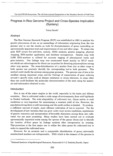Progress in Rice Genome Project and Cross-Species Implication (Synteny)
JIRCAS international symposium series
| ISSN | 13406108 |
|---|---|
| 書誌レコードID(総合目録DB) | AA1100908X |

本文フルテキスト
intlsymp-5_233-242.pdf242.94 KB
The Rice Genome Research Program (RGP) was established in 1991 to analyze the genetic phenomena of rice as an assemblage of information originating from the rice genome and to use the results as tools for characterization of genes controlling an agronomically important trait and improvement of rice and other crops. To attain this goal, RGP covers five activities, namely, cDNA analysis, genetic mapping, physical mapping, DNA marker application and database management. Genetic map with 2,292 DNA markers is utilized for accurate tagging of phenotypical traits and gene isolation. Our linkage map was constructed based mainly on RFLP markers which are advantageous for direct use as probes for detecting polymorphism among other crop species. The cross-hybridization of a marker from rice or other crops to both species can precisely identify the corresponding loci in both genomes. This method could clarify the synteny among grass genomes. The genome size of rice is the smallest among important crops and the findings of conservation of gene ordering around a specific trait, such as disease resistance or stress tolerance, in crops other than rice could facilitate the molecular characterization of the trait using the materials and information obtained in rice.
| 作成者 | Takuji Sasaki |
|---|---|
| 公開者 | Japan International Research Center for Agricultural Sciences |
| オンライン掲載日 | |
| 号 | 5 |
| 開始ページ | 233 |
| 終了ページ | 242 |
| 言語 | eng |
